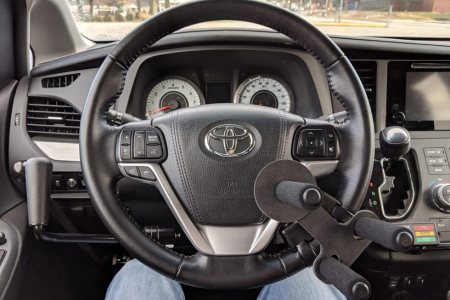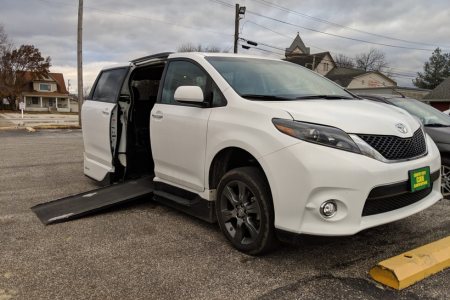
Is driving after a spinal cord injury even possible? That was one of the first questions, along with many others, that went through my mind as I was lying in a hospital bed after my spinal cord injury. I know I’m not the only one who’s ever wondered this. Well, the answer is yes! Thousands of people living with spinal cord injuries get to drive every day, including me!
Benefits of Driving After a Spinal Cord Injury
Personally, I waited nearly 4 years to be able to drive myself around again and let me tell you; I’m still enjoying the new freedom. Once they updated my Toyota Sienna with the right modifications, I spent my day doing something that I honestly once thought was impossible when I was still in my hospital bed after my accident in 2015. I drove to the store by myself to pick up a surprise Christmas present for my parents. Then, I went through the drive-through to get coffee and lunch. I wouldn’t have imagined this was something I’d ever be able to do again after my SCI, although it was always my goal.
Two of the main hurdles people often encounter after a spinal cord injury are a lack of independence and confidence. Now, I can tell you firsthand that being able to drive may help you overcome both hurdles.
Here are a few of the potential benefits of learning to drive again after your SCI:
Freedom
The ability to drive wherever and whenever without relying on others offers a great sense of new freedom.
Improved Mood
Being stuck inside all the time or having to depend on others to get somewhere can result in depression and a decreased sense of self-worth. However, being able to drive again after your injury might help you feel better again just by getting out in the sunshine and accomplishing errands by yourself again.
Normalcy
The sooner you’re able to drive, the sooner you may return to a normal life.
New Possibilities
Having the ability to drive a vehicle after a spinal cord injury opens up so many new possibilities and opportunities. For instance, you can go back to school or work on your own. You may feel freer to drive to in-person support groups or take part in adaptive sports. You might even want to take a road trip vacation. Either way, you’ll be able to socialize and feel like you’re part of the community.
Adaptive Vehicle Modifications for Disabled Drivers
So now you may be wondering how it’s possible for someone who is disabled to drive their own car. Thankfully, modifications can be made to cars, trucks, and vans for people with spinal cord injuries to ensure they can drive safely. The adaptations will suit each individual’s specific needs.
For example, here are the most common vehicle modifications:
Hand Controls
Drivers without the use of their legs can use hand controls to operate the accelerator and brake pedal.

Automatic Doors
Doors that open and close automatically are common on wheelchair-accessible vans. This makes opening and closing car doors easier.
Wheelchair Ramps and Lifts
Depending on the level of your spinal cord injury and physical ability, you may need to use a ramp so you can roll into your vehicle. Alternatively, a lift can get you up into the vehicle automatically as well as store your wheelchair during the drive.

Seat Adjusters
If you aren’t planning to drive your vehicle from your wheelchair, a modified seat that rotates for you to transfer from and to your chair may make it easier to get seated and ready to drive.
Be sure to take a look at the video I include near the end of this post so you can get an in-depth look at my driving setup.
Steps to Take Toward Driving a Modified Vehicle
Now that you know driving with a spinal cord injury is possible, what is the process to get there? Just because it’s possible doesn’t mean that everyone with a spinal cord injury has the ability to drive. This is why you must go through a series of steps through a driving rehabilitation program, which will ensure that you are eligible.
1. Clinical Evaluation
This will check your physical and mental abilities to make sure you’re fully able to drive without potentially causing harm to yourself or others. This evaluation includes knowledge of basic road signs, memory tests, muscle function tests, and vision tests.
2. Driving Test
Next, you need to take a driving test to determine what kind of adaptations you may need in order to drive safely. You will then get behind the wheel of a vehicle that’s modified with adaptations for spinal cord injured people, which will test your driving skills. Plus, it helps get you comfortable with this new way of driving.
3. Vehicle Modifications
Your vehicle must undergo the process of getting modifications installed to suit your specific needs. Your car may require a combination of the listed modifications above.
4. Training
Lastly, once you have a modified adaptive vehicle, you’ll need training sessions to learn how to drive your vehicle.
It does take some time to get to the point of driving after a spinal cord injury. The process of getting a clinical evaluation, driving test, vehicle modifications, and training done is quite lengthy. Be sure to start the process early. Although it does seem like it can take forever when you’re in the middle of the process, it’s definitely worth the wait. Soon, you could be driving with your independence and freedom back!
Take a look at the below videos to see my personal driving setup and how I drive as a C5/C6/C7 quadriplegic from my YouTube channel.